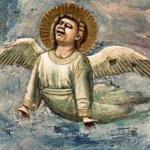After several years at sea rescuing besieged towns from monsters, slaying the Minotaur, and doing the things that mythical Greek heroes do, Theseus has decided that it’s time for he and his crew to take some well-deserved R and R. The name of the famous hero’s ship has been lost in antiquity—let’s call it the “Tachus,” after the ancient Greek word for “swift.” The Tachus has served Theseus and his entourage well over the years, but the ship is badly in need of repairs.

Knowing that “Jason’s Ship Repair” is the best boat repair establishment on the Aegean coast, Theseus and his crew float the Tachus into Dock Alpha for the necessary work to be done. Jason tells Theseus that the needed repairs will take about six months to complete. Theseus leaves a down payment and heads toward Athens for a long-awaited reunion with his wife Phaedra and their kids.
Jason’s approach to repairing the Tachus is methodical and time-consuming. One at a time, he carefully removes a plank from the Tachus and replaces it with a new plank that, to the inexperienced eye, looks identical to the original plank. Each replaced plank is numbered, then placed in an empty warehouse behind Dock Alpha. One by one, each plank on the Tachus is replaced with a new plank in precisely the same way. After thousands of such replacements, the Tachus is ready to return to sea. But the only thing that remains of the original ship that Theseus brought into port is its name. Not a single molecule of the original ship remains in Dock Alpha–all of the planks from the original ship are in the warehouse.
Jason and his team are so good at what they do that they finish the Tachus repairs in less than four months. Business is slow. But then Jason remembers the original planks from the Tachus in the warehouse. Realizing that there was nothing seriously wrong with that wood that careful joining couldn’t fix, Jason comes up with a plan to both keep his work crew busy and also make some money. “Guys!” Jason says. “We’re going to take all of that wood in the warehouse and build a new boat out of it at Dock Beta!” Over the next two months, that’s exactly what they do. Each original removed plank from the Tachus is carefully joined back to its neighboring planks, and slowly a new ship emerges at Dock Beta, constructed entirely out of the Tachus’ old planks. Working at record speed, Jason and his crew finish assembling the ship just days before Theseus is scheduled to pick up his repaired vessel.
When the time comes, Theseus is busy doing heroic things up north and sends his crew, led by second captain Bob, to settle accounts with Theseus and sail the Taches north to a rendezvous with Theseus. But here’s the question:
Which ship should Bob and the crew pick up: The ship at Dock A, or the ship at Dock B? Which of these two ships, identical to the naked eye, is the Tachus?
Think about it. A strong argument can be made in favor of (or against) either of the ships being the ship of Theseus. Bob and the crew will undoubtedly head for Dock Alpha, since that’s where they left the Tachus six months ago. But not a single inch of the ship at Dock Alpha is made of the same material as the ship left six months ago; every plank has been changed out. Alternatively, the ship at Dock Beta, although in a different location than where the Tachus was left six months ago, is made entirely of the same materials that the original Tachus was made of. Which ship belongs to Theseus depends on what standard of identity one is using to judge sameness over time.
I have frequently used this famous thought experiment in various classes over the years, any time we were doing a unit on “Identity.” How do we determine the identity of something over time? Everyone has said at one time or another, when considering a decision or action from the past, something along the lines of “I am not the same person now as I was then.” And you know, obviously, that you are the same person that made that choice or did that thing years ago. The ship of Theseus story is helpful as we try to sort out one of the fundamental puzzles of our world: How can something stay the same through the never-ending processes of change?
After a good deal of confusion, discussion, and debate, my students usually lean more and more toward the conclusion that the ship at Dock Alpha is the Tachus, and the ship at Dock Beta is an imposter, the “Schmachus,” perhaps. Even though the ship at Dock Alpha has none of the material that made up the original Tachus (and the ship at Dock Beta has all of that material), there’s something compelling about location and expectations. This intuition is bolstered by our regular experience that things can change in appearance and structure, sometimes noticeably, and still be the same thing. When you take your car for a tune-up and the mechanics replace at least a few worn out parts with new ones, you don’t argue that the car you pick up at the end of the day is not your car. It’s just your car with a few new parts in it.
Scientists tell us that every human being changes her or his cells out completely in seven to ten years. None of the millions of cells that currently make up your physical body were there ten years ago. None of them. And some cells change out much more quickly than seven years. In other words, you and I are living examples of the ship at Dock Alpha. Everything changes, yet still remains the “same.” What remains the same is not the stuff, or even the location, but something else entirely. What that something else is . . . that’s a fascinating and continuing philosophical question.
Since I investigate the intersection of philosophy and faith in real time and real life on this blog, I’m interested in reflecting for a moment about the ship of Theseus conundrum as it applies to faith and religious belief. I have written frequently over the years, including several times in the past few weeks, about how important doubt, flexibility, and change are to the life of faith. I do that because since God is supposedly eternal and unchanging, many religious perspectives seek to place the faithful person in a doctrinal straitjacket. How can my faith change, as everything does, but still be “my faith,” held together by a stable foundation? Consider a story from Benjamin Franklin’s autobiography.
Franklin lived during “The Great Awakening,” a remarkable religious revival in eighteenth-century New England. He was particularly intrigued by the Dunkers, a small Baptist sect (who “dunked” the newly baptized) that would become the Church of the Brethren a couple of centuries later. One of the Dunker leaders complained to Franklin that, as often happens when religion is concerned, other religious groups frequently accused the Dunkers of “abominable practices and principles, to which they were utter strangers.”
Franklin sensibly suggested that the Dunkers should publish “the articles of their belief, and the rules of their discipline,” something that the majority of Christian sects and denominations still do, thus reducing the opportunity for misunderstanding and slander. To which the Dunker leader remarkably replied as follows:
When we were first drawn together as a society, it had pleased God to enlighten our minds so far as to see that some doctrines, which we once esteemed truths, were errors; and that others, which we had esteemed errors, were real truths. From time to time He has been pleased to afford us farther light, and our principles have been improving, and our errors diminishing. Now we are not sure that we have arrived at the end of this progression . . . we fear that, if we should once print our confession of faith, we should feel ourselves as if bound and confin’d by it, and perhaps be unwilling to receive farther improvement, and our successors still more so, as conceiving what we their elders and founders had done, to be something sacred, never to be departed from.
I like the Dunkers’ attitude. Doctrine bothers me because it so easily turns into its evil and rigid twin, dogma. Remember the ship of Theseus. The ultimate test of a ship is not whether it retains the same planks, and certainly isn’t whether it stays in a predictable place. The test of a ship is whether it is seaworthy. How well does it work? That might be a good question to regularly ask about one’s faith.
Not long ago I heard someone mention that she is comforted by the fact that the words she is saying when reciting the Nicene Creed are the very same words Christian believers have recited for close to two millennia. I’m not sure why that’s something to be comforted by. I am reminded of something I read from Christian Wiman’s My Bright Abyss not long ago: “Only when doctrine itself is understood to be provisional does doctrine begin to take on a more than provisional significance.”












